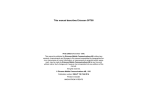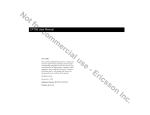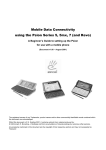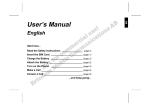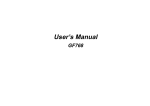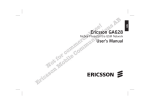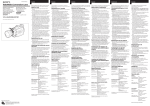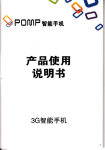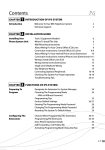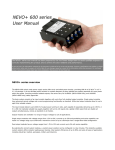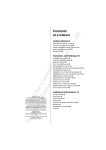Download NotforCommercialUse EricssonMobileCommunicationsAB
Transcript
e s s U n o l i a t i a c c r i e n u m m mm o C Co r o le f t bi o N Mo n o s s ic This manual describes Ericsson GF788e r E EN/LZT 126 1433 R1A B A e s s U n o l i a t i a c c r i e n u m m mm o C Co r o le f t bi o N Mo n o s s ic First edition (January 1998) This manual is published by Ericsson Mobile Communications AB, without any warranty. Improvements and changes to this manual necessitated by typographical errors, inaccuracies of current information, or improvements to programs and/or equipment, may be made by Ericsson Mobile Communications AB at any time and without notice. Such changes will, however, be incorporated into new editions of this manual. All rights reserved. © Ericsson Mobile Communications AB, 1998. Publication number: EN/LZT 126 1433 R1A Printed in Sweden r E INNOVATRON PATENTS EN/LZT 126 1433 R1A B A Guidelines for Safe and Efficient Use e s s U n o l i a t i a c c r i e n u m m mm o C Co r o le f t bi o N Mo n o s s ic Important: Read this information before using your portable phone General Since its introduction in the mid 1980s the portable phone is one of the most exciting and innovative products ever developed. With it, you can stay in contact with your office, your home, emergency services, and others. Your telephone is a radio transmitter and receiver. When it is ON it receives and also sends out radio frequency (RF) energy. Depending upon the type of mobile phone you have purchased, it operates in different frequency ranges and employs commonly used modulation techniques. When you use your phone, the system handling your call controls the power level at which your phone transmits. phone. According to this statement, which is based on the available body of research, there is no evidence that mobile terminals meeting the recommended limits can cause any adverse health effects. All Ericsson telephones conform to the ICNIRP recommendations, and international exposure standards, such as: CENELEC European Pre-standard ENV50166-2 ANSI/IEEE C95.1-1992 (USA, Asia- Pacific) If you want to limit RF exposure even further, you may choose to control the duration of your calls and operate your phone in the most power efficient manner. For the safe and efficient operation of your phone, observe these guidelines. Efficient phone operation Exposure to radio frequency energy Hold the phone as you would any other telephone. While speaking directly into the mouthpiece, angle the antenna in a direction up and over your shoulder. If the antenna is extendable, it should be extended during a call. The International Commission on Non-Ionizing Radiation Protection (ICNIRP), sponsored by the World Health Organization (WHO), published a statement in 1996 which sets limits for exposure to RF fields from handheld mobile r E How to use your phone for optimum performance with minimum power consumption: Do not hold the antenna when the phone is IN USE. Holding the antenna affects call quality, EN/LZT 126 1433 R1A B A may cause the phone to operate at a higher power level than needed and shorten talk and standby times. Antenna care and replacement Do not use the phone with a damaged antenna. Replace a damaged antenna immediately. Consult your manual to see if you may change the antenna yourself. If so, use only an Ericsson approved antenna. Otherwise, take your phone to a qualified service centre for repair. Use only the designated Ericsson antenna. Unauthorized antennas, modifications, or attachments could damage the phone and may violate the appropriate regulations. Do not use an antenna designed for any other type of portable telephone than the telephone you have purchased. Driving Check the laws and regulations on the use of telephones in the areas where you drive. Always obey them. Also, when using your phone while driving, please: Give full attention to driving. Use hands-free operation, if available. i Pull off the road and park before making or answering a call if driving conditions so require. risk of interference is limited. Contact your cardiologist for more information. RF energy may affect some electronic systems in motor vehicles. In addition, some vehicle manufacturers forbid the use of mobile phones in their vehicles. Check with your vehicle manufacturer’s representative to be sure your phone will not affect the electronic systems of your vehicle. Aircraft Electronic devices To prevent possible interference with aircraft systems, safety regulations require you to have permission from a crew member to use your phone while the plane is on the ground. To prevent interference with communication systems, you must not use your phone while the plane is in the air. e s s U n o l i a t i a c c r i e n u m m mm o C Co r o le f t bi o N Mo n o s s ic Most modern electronic equipment, for example, equipment in hospitals and cars, is shielded from RF energy. However, RF energy from telephones may affect some electronic equipment. Turn your phone OFF in health care facilities when regulations posted in the areas instruct you to do so. Always request permission before using your phone near medical equipment. Mobile telephones may affect the operation of some implanted cardiac pacemakers, equipment for people with hearing impairments and other medically implanted equipment. Pacemaker patients should be aware that the use of a mobile phone very close to a pacemaker may cause the device to malfunction. Avoid placing the phone over the pacemaker, i.e. in your breast pocket. When using the phone, place it at your ear opposite the pacemaker. If a distance of 15cm. is kept between the phone and the pacemaker, the Turn your phone OFF before boarding any aircraft. Use it on the ground only with crew permission Turn off your phone before the aircraft leaves the ground. Do not use it in the air. Power Supply Connect AC (Power supply) only to designated power sources as marked on the product. To reduce risk of damage to electric cord, remove from outlet by holding onto AC adapter rather than cord. Make sure the cord is located so that it will not be stepped on, tripped over or otherwise subjected to damage or stress. To reduce risk of electric shock, unplug unit from power source before attempting any cleaning, then use soft cloth dampened on with water. r E ii Children EN/LZT 126 1433 R1A B A Do not allow children to play with your phone. It is not a toy. Children could hurt themselves or others (by poking themselves or others in the eye with the antenna for example). Children could also damage the phone or make calls that increase your telephone bills. Blasting areas To avoid interfering with blasting operations, turn your unit OFF when in a “blasting area” or in areas posted “turn off two-way radio”. Construction crews often use remote control RF devices to set off explosives. Potentially explosive atmospheres Turn your phone OFF when in any area with a potentially explosive atmosphere. It is rare, but your phone or its accessories could generate sparks. Sparks in such areas could cause an explosion or fire resulting in bodily injury or even death. Areas with a potentially explosive atmosphere are often, but not always, clearly marked. They include fuelling areas, such as gas stations, below deck on boats, fuel or chemical transfer or storage facilities, and areas where the air contains chemicals or particles, such as grain, dust, or metal powders. Do not transport or store flammable gas, liquid, or explosives in the compartment of your vehicle which contains your phone and accessories. e s s U n o l i a t i a c c r i e n u m m mm o C Co r o le f t bi o N Mo n o s s ic Product care Do not expose product to water or moisture. Example: bathtub, laundry sink, wet/damp basement, swimming pools, etc. Do not expose product to extreme temperatures such as found near a hot radiator or stove, or in a car parked in the sun. Do not expose product to extreme cold temperatures such as a car parked outdoors in winter Do not expose product to lit candles, cigarettes, cigars, open flames, etc. Use only Ericsson Original accessories. Failure to do so may result in loss of performance, fire, electric shock, or injury, and will void the warranty. The symbol on our products signifies that they have been certified according to the EMC directive 89/336/EEC, the Telecommunications directive 91/263/EEC, and the Low Voltage directive 73/23/EEC when applicable. The products fulfil the requirements according to the following standards: B A Cellular Phones and Accessories in Combination:ETS 300 342-1 EMC for European digital cellular telecommunications. Accessories Without Direct Connection to a Cellular Phone:EN 50081 Electromagnetic compatibility, Generic Emission Standard, and EN 50082 Electromagnetic compatibility, Generic Immunity Standard. Do not attempt to disassemble the product. Doing so will void warranty. This product does not contain consumer serviceable components. Service should only be performed by Authorized Service Centres. r E EN/LZT 126 1433 R1A iii e s s U n o l i a t i a c c r i e n u m m mm o C Co r o le f t bi o N Mo n o s s ic r E iv EN/LZT 126 1433 R1A B A Table of Contents e s s U n o l i a t i a c c r i e n u m m mm o C Co r o le f t bi o N Mo n o s s ic Guidelines for Safe and Efficient Use i Assembly Instructions 1 Assemble and Charge – Four Steps 1. Inserting SIM Card 2. Attaching Battery 3. Connecting Charger to Phone 4. Connecting Charger to Mains The Charging Function The Battery and the SIM Card 3 Turning On the Phone and General Information 4 Turning On the Phone Learning about Your Phone Making and Receiving Calls Making a Call Ending a Call Making an International Call Making an Emergency Call Retry Function r E 1 1 2 2 2 3 4 6 7 7 7 7 7 7 Receiving a Call Answering a Call Rejecting a Call Putting a Call on Hold Calling Line Identification (CLI) Handling Two Calls Conference Calls Transferring Calls Line 2 Option 8 8 9 9 9 Useful Information while Talking 10 Changing Volume while Talking Using Phone as Scratch Pad Sending Tone Signals Checking Time or Cost of Calls Navigating the Menu System About the Menu System Moving Through the Menu System Selecting the Extended Menus Creating Your Own Phone Book The Phone Book EN/LZT 126 1433 R1A 7 7 8 8 10 10 10 10 11 11 11 11 12 12 Storing Numbers on SIM Card Storing Numbers in Phone Memory Entering Letters Recalling Phone Numbers Position Recall Changing Phone Book Entry Last Dialled Numbers Unanswered Calls Personalizing Your Phone Changing Ring Volume Changing Earpiece Volume Ring Type Viewing the Clock Setting Clock Setting Alarm Turning Off the Alarm Display Language Answering Modes Handsfree Types Greeting Call Waiting Call Information Changing Key Sound Choosing Message Signal B A 12 12 13 13 13 14 14 14 15 15 15 15 15 15 15 16 16 16 16 16 16 17 17 17 v Making Your Personal Ring Signal Customizing Your Reduced Menu Diverting Calls Diverting Calls Diverting from Reduced Menu Diverting from Extended Menu Viewing Status of Call Divert Cancelling Call Divert 18 18 19 19 19 19 20 20 Protecting Your Keypad, Phone and SIM Card 21 Locks Keypad Lock Card Lock (SIM) Changing PIN Unblocking with PUK Phone Lock (Un)Locking Phone 21 21 21 21 21 21 22 Barring Calls – Restricting Calls Barring Calls Activating Call Bars for Any Call Type Cancelling All Call Bars 23 23 23 Customizing Menus Adding Menus Changing Menu Position Deleting Menus Resetting Menus to Original Sending and Receiving Text Messages Text Messages Checking Subscription Setting Service Centre Address Sending SMS Other Message Types Receiving a Message Reading an Old Message Receiving Area Information Area Information Activating the Area Information Adding a Code Erasing a Code Changing a Code 23 r E vi Knowing Cost and Duration of Calls e s s U n o l i a t i a c c r i e n u m m mm o C Co r o le f t bi o N Mo n o s s ic Phone Note System Simple Melody 18 EN/LZT 126 1433 R1A 24 24 24 24 24 24 25 25 25 25 25 25 26 26 27 27 27 27 27 27 Call Time Call Cost Specific Data Menus Having Data Menus On Diverting Fax and Data Calls Other Networks Choosing Network Selecting a Network Index B A 28 28 28 29 29 29 30 30 30 31 Assembly Instructions e s s U n o l i a t i a c c r i e n u m m mm o C Co r o le f t bi o N Mo n o s s ic Assemble and Charge – Four Steps ● Insert the SIM Card. ● Attach the battery. ● Connect the charger to the phone. ● Connect the charger to the mains. r E 1. Inserting SIM Card Place the SIM Card with the golden connectors facing down and the cut corner turned to the left (see Figure 1). Slide the SIM Card into the SIM Card slot. The SIM release button slides towards the antenna as you push in the SIM Card. Removing SIM Card 1. Make sure the battery is removed. 2. Slide the SIM release button towards you (see Figure 2). 3. Pull out the SIM Card. 1. 1. 2. 2. Figure 1. Inserting SIM Card EN/LZT 126 1433 R1A B A Figure 2. Removing SIM Card 1 2. Attaching Battery Disconnecting Charger 1. Make sure the phone is turned off. Lift the plug up and pull it out (see Figure 5). e s s U n o l i a t i a c c r i e n u m m mm o C Co r o le f t bi o N Mo n o s s ic Place the battery on top of the phone. Push until you hear a click (see Figure 3). 2. Press the catch on the bottom of the battery (see Figure 4.). 3. Lift the battery up and away from the phone. 1. B A Removing Battery 1. To mains 2. 2. 3. r E Figure 3. Attaching battery 2 Figure 4. Removing battery Figure 5. Connecting and disconnecting charger 3. Connecting Charger to Phone 4. Connecting Charger to Mains Have the battery attached to the phone and connect the charger as described in Figure 5. Use the power plug that fits your mains. Plug the charger into a mains socket. The battery tarts charging. You can see the battery meter in the display move while charging. EN/LZT 126 1433 R1A B A The Charging Function The Battery and the SIM Card phone number, the services that you order from the service provider and your phone book information. When you connect external power to the phone, the battery starts charging. When the battery is fully charged, the charging stops. You cannot overcharge your battery. The Battery Your phone is supplied with a Nickel Metal Hydride battery. The battery is not charged before shipment, even though there might be enough power to turn the phone on. Your SIM Card is supplied with a security code or PIN (Personal Identity Number). You must enter this into the phone to gain access to the phone and network. e s s U n o l i a t i a c c r i e n u m m mm o C Co r o le f t bi o N Mo n o s s ic When you are charging the battery, you can use your phone as normal, but the charging time will be longer. The SIM Card Before you can start using your phone, you need to order a SIM Card from a GSM service provider. The SIM Card keeps track of your r E EN/LZT 126 1433 R1A Note! Some services described in this manual may not be avialable in all networks. Please, see you service provider for more information. 3 Turning On the Phone and General Information e s s U n o l i a t i a c c r i e n u m m mm o C Co r o le f t bi o N Mo n o s s ic Turning On the Phone 1. Press and hold down the NO key until you hear a click. The display prompts you to enter your PIN (the security code that follows your SIM Card). When your phone finds a network, the indicator light on the top of the phone flashes green once every second. The standby display is shown (see Figure 6). 3,1 2. Enter the PIN and press YES. The PIN is indicated as in the display. Figure 6. Standby display If you entered the PIN correctly, you will be welcomed by your phone. Then it searches for a network. r E 4 EN/LZT 126 1433 R1A Turning Off the Phone ● B A Press and hold down the NO key until you hear a click and the display turns dark. The Display e s s U n o l i a t i a c c r i e n u m m mm o C Co r o le f t bi o N Mo n o s s ic Your phone display helps you to: Make sure that you are dialling correctly. ● Check your battery status. ● Check your signal strength and service availability. ● Indicate that you have received messages. ● Table 1. Description of display icons. Icon: :25/' Indicates: B A Network The name and country of the network. Signal Strength The received signal strength in five steps. Looking at the Display The picture below shows what the display looks like when the entire icon row is lit. Table 1 explains what each icon means. Line Whether line 1 or 2 is active. These icons only show if you have two lines on your SIM Card. Divert That the phone has a divert active. The arrows corresponds to the diverted line. Silent Ring Signal That no ring signal sounds when the phone is rings. Figure 7. Display with all icons lit Note! All icons may not be visible at all times. Letter That you have received a short text message or area information. Phone That you are engaged in a call. Battery The current battery strength – more bars there are the more power there is. r E EN/LZT 126 1433 R1A 5 Learning about Your Phone e s s U n o l i a t i a c c r i e n u m m mm o C Co r o le f t bi o N Mo n o s s ic 1. 2. The parts list corresponds to Figures 8 and 9: 1. Antenna 3. 2. Status light 3. Earpiece 13. 4. 4. Volume keys 5. Display 5. 6. Keypad 7. Microphone (inside) 6. 8. Flip 9. Microphone channel 12. 7. 10. Charging connector 11. Battery 12. SIM release button 8. 11. 13. Phone clip holder 10. 9. Figure 8. Front view of your phone r E 6 EN/LZT 126 1433 R1A Figure 9. Rear view of your phone B A Making and Receiving Calls e s s U n o l i a t i a c c r i e n u m m mm o C Co r o le f t bi o N Mo n o s s ic Holding the Phone Making a Call 1. Enter the area code and phone number. The phone number appears in the display. If the number is longer than 10 digits, the beginning of the number is shown as an arrow (see Figure 10). Put the earpiece to your ear for the best speech and reception quality (see Figure 11). Making an Emergency Call B A Enter 112 (the international emergency number) and press YES. The display shows Emergency. The 112 emergency number can be used in any country with or without a SIM Card, if a GSM network is within range. ● Note! Some GSM networks do not support the international emergency number. Figure 10. Number with more than 10 digits To erase a digit, press CLR. To erase the entire phone number, press and hold down CLR for a couple of seconds. 2. Press YES to make the call. The display shows Calling, followed by Connecting. The phone icon appears. If the number is busy, you hear a busy tone and the display shows Busy. Figure 11. Holding your phone Retry Function Ending a Call If the call connection fails, the display shows Retry? Press YES to redial the number, otherwise NO. ● Press NO to end the call. Making an International Call Receiving a Call 1. Press and hold the zero key until the international + sign is displayed. When you receive a call, the phone rings and the indicator light on the top of the phone blinks green rapidly. The display shows Answer? 2. Enter the country code, area code (without any leading zero) and the phone number. Answering a Call 3. Press YES to make the call. ● ● r E EN/LZT 126 1433 R1A Press YES to answer the call When the call is finished, press NO. 7 Rejecting a Call ● Receiving a Second Call While a Call Is in Progress If you subscribe to withhold your number when calling, you can show the number on a particular call. When you receive a second call, you will hear a tone in the ear piece and the display shows Call Wait. 1. Enter the number you wish to call. ● e s s U n o l i a t i a c c r i e n u m m mm o C Co r o le f t bi o N Mo n o s s ic Press NO or a volume key twice when the phone rings. The display now looks like this: %USY7ONE If the caller’s network supports it, the caller hears a busy tone. If you have been unable to answer, or you have rejected a call, the number of the unanswered call is shown in the display until you press CLR (this depends on your subscription). Putting a Call on Hold 2. Press . The display shows Send Id? Hiding Your Phone Number If you subscribe to show your number when calling, you can hide your number on a particular call. If you are engaged in a call, you can put it on hold by pressing YES. This mutes the microphone so that you can have a private conversion without the person at the other end hearing. To put the call off hold, press YES again. 2 Press twice. The display shows Hide Id? Calling Line Identification (CLI) Your phone can handle two calls simultaneously. This allows you to hold one call and make or receive another. You can switch between the two calls. 3. Press YES to make the call. Handling Two Calls To receive a second call, you must activate the Call Wait function (see the chapter on Personalizing Your Phone on page 12). r E 8 EN/LZT 126 1433 R1A Press YES answer the second call. The current call is put on hold. The display now looks like this. 2N +OLD 3. Press YES to make the call. 1. Enter the number you wish to call. The Calling Line Identification service shows the caller’s phone number when you receive a call (you have to order this service). If the caller’s name is stored in your phone book, the name is displayed instead of the number. B A Showing Your Phone Number ● To reject the second call, press zero followed by YES. Switching Between Two Calls ● Press YES to switch between the two calls. Ending the Current Call and Return to the Held Call 1. Press NO to end the current call. The display shows Retrieve? and you hear two beeps. 2. Press YES within three seconds to return to the held call. If you do not press YES within three seconds, the held call is ended automatically. Making a Second Call while a Call Is in Progress ● may put an individual or a group or conference members on hold while you add other people to the conference call. You may also put conference members on hold while you talk to someone privately. e s s U n o l i a t i a c c r i e n u m m mm o C Co r o le f t bi o N Mo n o s s ic Enter the second phone number and press YES. The first call is put on hold and the display looks like this: 2N +OLD The Conference Call service may not be available in all networks. Contact your operator to find out whether your network supports it. Receiving a Third Call If you are engaged in one call and have a second one on hold, you may receive a third call. You hear a tone in the ear piece and CallWait is shown in the display. Initiating a Conference Call 1. Call the first person you wish to include in the conference call. 2. Put this person on hold by pressing YES. You can only have one call on hold at a time, so you need to end the first or second call before you answer the third one. 3. Call the second person you wish to include in the conference call. You can do one of the following: 4. Press 3, then YES to include the two people in the conference. Press zero and then YES to reject the third call. End the first call, retrieve the held call, and answer the incoming call. ● End both calls. The phone rings and the question Answer? appears in the display. Press YES to answer the call. ● ● Conference Calls The conference call service allows you to have a joint conversation with up to five people. You You can put the conference group on hold and then add a third member by repeating steps 2 to 4. It is possible to add up to five members in this way. Transferring Calls If you have one active call and another call on hold, you can connect the two by pressing 4, r E EN/LZT 126 1433 R1A B A then YES. You are then disconnected from both calls. Line 2 Option Your phone can support two phone lines if your service provider offers this service. Having two different phone numbers on the same SIM Card makes it easy to keep business and private calls separate. When you receive a call, the display shows Answer? After that it toggles between L1? (or L2?) and the caller’s number. When you want to make a call, you choose the phone line by toggling between L1 and L2). ● To toggle between L1 and L2, press the right arrow key then YES. Divert L1 and L2 When a second line is introduced, Line 2 is added to the menu structure and the Divert menu splits into Divert L1 and Divert L2 so that you will be able to divert each line separately (see Chapter Diverting Calls on page 19). You can divert Line 1 to an answering machine, for instance, and keep Line 2 active. 9 Useful Information while Talking e s s U n o l i a t i a c c r i e n u m m mm o C Co r o le f t bi o N Mo n o s s ic B A Changing Volume while Talking Using Phone as Scratch Pad Checking Time or Cost of Calls During a call, you can use the volume keys to increase or decrease the earpiece volume (see Figure 12). 1. Enter a phone number on the keypad while talking. When you end the call, the number remains in the display. When you start a call (incoming or outgoing), the airtime is counted in minutes and seconds and shown in the display like this: 2. Press YES to make the call in the display. Sending Tone Signals Figure 12. Changing volume During a call you can press keys 0 – 9, and to send DTMF tones. For example, to use telephone banking services or to control an answering machine. r E 10 EN/LZT 126 1433 R1A If you want the phone to keep track of the costs you need to set that specifically. Check if your service provider supports this service (see chapter Knowing Price and Duration of Calls on page 28). Navigating the Menu System e s s U n o l i a t i a c c r i e n u m m mm o C Co r o le f t bi o N Mo n o s s ic move menus and sub-menus from the extended menu system to the reduced. About the Menu System You control the functions of your phone by a menu system. There are two sizes: Rreduced Extended In this manual package, there is a separate leaflet which describes all the original settings of both the reduced and extended menu system. ● ● Hint! When you go through this manual, have the leaflet with all menus handy at the same time. Some menus have sub-menus that have individual settings. If the menu has sub-menus, three dots appear after the menu name. See the example below: 6ETTINGS The Reduced Menus The reduced menu consists of those functions and settings you probably use most. This menu system can be personalized to fit your specific needs. When you personalize the system, you You learn how to personalize your menus in Customizing Your Reduced Menu System on page 24. The Extended Menus The extended menu contains all the functions and settings available from the phone. Moving Through the Menu System Use these keys to move through the menu system and to find the different menus. Press: YES NO CLR To: B A confirm a setting or a selection. reject a setting or a function. return to the standby display. scroll to the right in the menu system. scroll to the left in the menu system. Glossary These terms will be used throughout the manual: Scroll: Press the left or right arrow key to move between the menus. Select: Scroll to a menu and then press YES. Enter: Key in letters or numbers from the keypad. Selecting the Extended Menus When you reach the desired menu, press YES to choose the menu. Use the / keys until you reach the function or setting you want. Then, in the same way you chose a menu, press YES to select the setting or function. r E EN/LZT 126 1433 R1A 1. Press CLR to clear the display. Press the left arrow key four times until you reach the Menu Size menu. 2. Press YES. You are now in the Menu Size menu where you can switch to the Extended menu mode. 3. Press YES at the Extend prompt. 11 Creating Your Own Phone Book e s s U n o l i a t i a c c r i e n u m m mm o C Co r o le f t bi o N Mo n o s s ic The Phone Book You can store phone numbers in two places: on your SIM Card and in your phone’s own memory. The choice is based on your needs. If you use one SIM Card in many phones, the phone book stored on the SIM Card is always available to you. If you have one telephone and use several SIM Cards, the phone’s phone book is always available to you. You can store up to 99 phone numbers in the phone memory. SIM Card capacities vary. International Numbers If you intend to use your phone book both at home and abroad, you should store all phone numbers as international phone numbers, i.e. with the international (+) sign and the country code before the area code (without any leading zero) and the number. ● To enter the (+) sign, press and hold 0 (zero) until you see + in the display. Speed Dialling The phone numbers that you store in positions 1– 9 on the SIM Card can be called by entering the position number and then pressing YES. You should, therefore, save positions 1–9 for important numbers. r E 12 Storing Numbers on SIM Card 1. Select the Store menu (second to the left from standby) by pressing YES. 2. If you don’t have the right phone number in the display from the start, clear the display and enter it now. 3. Press YES. The display shows Name: 4. Enter the first letter of the name by tapping the key with the appropriate letter. If it is the second letter, you need to tap the key twice to produce it (see Entering Letters). Wait for the cursor to move to the right before entering the next letter. The number of characters allocated for each name vary with SIM Cards. Press YES when you have keyed in the name. The display shows POS: and a number. This is the first available position on the SIM Card. 5. If you want the storage position suggested in the display, press YES (see step 6). If you want to store the number in a different position, press CLR to erase the suggested position number and enter another number. If you choose a position number that is already occupied, Overwrite? is displayed. Press YES to EN/LZT 126 1433 R1A B A overwrite or NO to return to the position number and change it. 6. Press YES to confirm the position number. The display briefly shows Stored. The listing has been saved. The display changes to Store. You are back to the Store menu and can now enter another phone number. Storing Numbers in Phone Memory Follow the same procedure as for storing phone numbers on SIM Card, up to step 5. This is where you are prompted to accept or reject a storage position number. The suggested number is for a SIM Card position, if there is one available. Otherwise the phone suggests a position in the Phone memory. Clear the number by pressing CLR. Access the phone memory by pressing . The symbol } appears in the display. Press again. The symbol } is now followed by a number which represents the first available position in the phone memory. Confirm by pressing YES or change the digit. Entering Letters e s s U n o l i a t i a c c r i e n u m m mm o C Co r o le f t bi o N Mo n o s s ic You can enter letters and other characters using the keypad: Press the appropriate key, 1-9, 0 or repeatedly until the desired letter, character or digit appears in the display. For example, to enter an A, press number key 2. To enter B, press number key 2 twice. 1 2 3 4 5 6 7 8 9 0 Space - ?! , . : “ ’( ) 1 ABCÅÄÆàÇ2G DEFèÈ3DF GHIì4 JK L 5 L MNOÑÖØò6 PQRSb7PS TUVÜù8 WXYZ9 0+&@/$%£QXYW Note! Pressing one of the volume keys together with a number key, will get you to the second or third letter position directly. 4. Press YES to call the number. Recalling by Number – Speed Dialling 1. Press CLR to erase any digits from the display. 2. Enter a position number between 1 and 9. 3. Press YES to make the call. To exit the letter mode and return to standby, clear the display, by pressing CLR. Then press CLR again. Position Recall Recalling Phone Numbers 2. Press YES to call the number, or scroll until you find the number you want to call and press YES. You can recall a phone number any time from either the SIM Card or the phone memory. You can recall the phone number either by the name or the storage position number. Recalling by Name Note! In the letter mode, you can still enter digits but they are positioned deep. Hold down the key until the digit appears in the display instead of tapping. r E Enter the letter A for example and then press *. The capital A is replaced by a lower case a. All letters will now be lower case until you press * again. B A The selected name and number flash in the display until you press the key. Entering Lower Case Letters 1. Press CLR to erase any digits from the display. From SIM Card 1. Enter the position number and press . Press CLR to return to the standby display with the number showing. ● Press NO to return to the standby display. ● From Phone Memory 1. Press and hold until the } symbol appears. 2. Select the RecallName menu. You are prompted to enter a name. 2. Enter the position number. 3. Enter either the full name or the first letter and press YES. The first name that matches the letter is displayed. If necessary, scroll to the name you want. 4. Press YES to call the number, or scroll until you find the number you want to call and press YES. EN/LZT 126 1433 R1A 3. Press to recall number. 13 Press YES to confirm, and NO to change the position. Changing Phone Book Entry e s s U n o l i a t i a c c r i e n u m m mm o C Co r o le f t bi o N Mo n o s s ic 1. Select the EditPhBook menu. Deleting Storage Position 2. Enter either the full name or the first letter and press YES. The first name that matches the letter is displayed. If necessary, scroll to the name you want and press YES. 1. Select the RecallName menu. 3. Scroll through the name to change it letter by letter and press YES. The phone number is displayed. 4. Scroll through the phone number to change it digit by digit and press YES. The position number is displayed. 5. Enter a new position number and press YES. If the new position is already occupied, you will be asked to Overwrite? the position. 2. Choose the name you want to delete, press and hold CLR. Unanswered Calls Sometimes you are unable to answer a call. Then the phone keeps track of your latest missed calls in the MissedCall menu. 3. Press YES at the Erase prompt. Last Dialled Numbers Your phone can store at least the five last numbers dialled. You may be able to store more, depending on your SIM Card. Checking Unanswered Calls Select the MissedCall menu. The time of the missed call is shown. Now do one of the following: Press YES to see who the call is from (CLI). ● Press CLR to erase the call. ● Recalling From List of Last Dialled Numbers 1. Press CLR to erase any digits from the display. 2. Press YES. The number last called is shown. r E 14 B A 3. Press YES to call the number or scroll to the number you want to call. EN/LZT 126 1433 R1A Personalizing Your Phone e s s U n o l i a t i a c c r i e n u m m mm o C Co r o le f t bi o N Mo n o s s ic Changing Ring Volume Ring Type 1. Select the Ring Vol menu. 2. Scroll to the desired ring volume, press YES. Use the volume keys to scroll silently. Turning Off Ring Volume 1. Select the Ring Vol menu. 2. Press the left arrow key until no squares are lit and press YES. The standby display now looks like this: You can choose between different types of ring signals. You can also choose a melody that you have created yourself (see the chapter on Making Your Personal Ring Signal on page 18). Changing Ring Type 1. Select Ring Type in the Settings menu. The display now looks like this. 0ELODY " 2. Press the right or left arrow to listen to the different ring types. Use the volume keys to scroll silently. 3. Press YES to select your preferred ring type. Viewing the Clock Changing Earpiece Volume 1. Select Ear Volume in the Settings menu. The display now looks like this: If you want to view the time on your phone, press one of the volume keys on the side of the phone. Setting Clock 2. Press the the right arrow to increase the volume or the left arrow to decrease the volume. 1. Select Set Clock in the Settings menu. The display now looks like this. 3. Press YES when you are finished. r E EN/LZT 126 1433 R1A 2. Enter the correct time. 3. Press YES. Press to toggle between am and pm. B A Press to toggle between 12- hours and 24hours. Setting Alarm 1. Select the Set Alarm menu. The last alarm time is shown. 2 Enter the alarm time. 3. Press YES. The standby display now looks like this: :ORLD Your alarm works even when the phone is turned off. When the Alarm Rings... 1. Press any key and the Turn Off prompt appears. 2. Press YES to turn it off completely or any key to activate the snooze function (9 minutes). 15 Turning Off the Alarm Any key:You answer by pressing any key, except NO, on the phone keypad. e s s U n o l i a t i a c c r i e n u m m mm o C Co r o le f i ot b N Mo n o s s ic 1. Select the Set Alarm menu. The Off prompt appears. Changing Answering Mode 2. Press YES. 1. Select Answ Mode in the Settings menu. Display Language 2. Select the option you wish to have for your handsfree equipment. Your phone has many languages to choose from for your display. Note! When you change language, you change all display texts immediately. Changing Display Language 1. Select Language in the Settings menu. 2. Scroll to the language you want to have in your display texts. 3. Press YES to select the language. ● To turn off the handsfree option, choose Off in the Answ Mode sub-menu. Handsfree Types If you have transmission problems with your Handsfree equipment, you can try the Type 1 setting (Type 2 is default). Type 1: Half-duplex transmission. Type 2: Duplex transmission. Changing Handsfree Type 1. Select Handsfree in the Settings menu. Resetting Display Language to English 2. Select either Type 1 or Type 2. 1. Clear the display. 2. Enter the digit string 0000 . Answering Modes Two additional answering modes are possible for your phone is connected to handsfree equipment. The two modes are: Greeting A greeting appears after you enter your PIN. The default greeting is: Ericsson. You can also turn the greeting off. Off: On: No text is displayed at startup. Welcome or your own message is displayed at startup. Automatic:The phone answers the call automatically after two ring signals. r E 16 Making Your Own Greeting EN/LZT 126 1433 R1A B A 1. Select Greetings in the Settings menu The display now looks like this. 1EW 7EXT 2. Select New Text. 3. Enter the new text from your keypad and press YES. +ELLO You can have up to 10 characters in the greeting text. Call Waiting When activated the call waiting function allows you to handle two calls at a time. You may need to order this feature from your service provider. To handle two calls, see the chapter on Making and Receiving Calls on page 6. Activating/Deactivating Call Waiting Function 1. Select Call Wait in the Settings menu. 2. Select either Activate or Cancel . Call Information This function lets you present call information in either time or cost. To set the cost and time B A counter (see chapter Knowing Price and Duration of Calls on page 28). Changing Key Sound 1. Select Key Sound in the Settings menu. Choosing Message Signal Activating Call Information 2. Select the key sound you want. 1. Select Mail Alert from the Settings menu. e s s U n o l i a t i a c c r i e n u m m mm o C Co r o le f t bi o N Mo n o s s ic 1. Select Call Info in the Settings menu. 2. Select the call information (cost or time) you want displayed and press YES. r E EN/LZT 126 1433 R1A 2.Choose the sound you want to hear when you receive a text message (SMS). 17 Making Your Personal Ring Signal e s s U n o l i a t i a c c r i e n u m m mm o C Co r o le f t bi o N Mo n o s s ic Phone Note System Simple Melody Your phone can handle a range of notes over two octaves. This song corresponds to the C, D, and E tones on a music scale. Look at Table 2 to understand which notes and other notations correspond to which keys. Figure 13 also explains which key goes with which note on the keypad. Creating Do-Re-Me 1. Select Edit Melody in the Settings menu. Your display now looks like this. @ Pressing and holding a key gives you a long note. 3. Press 2. 4. Press 3. The display now looks like this: CDE@ 5. Press YES to test the melody. The phone plays the melody and asks you if you want to save it. 6. Press YES to save the melody as an alternative in the Ring Type menu. 2. Press 1. Table 2. List of musical notation. Press this: To: 1–9 insert notes, where 1 gives a C and 9 a high D. Figure 13. Keypad in musical notes increase or decrease the pitch in half tone steps. Press once for sharp (#), twice for flat (b), three times to get the normal pitch. insert a short pause (1/8). scroll within the melody. Press and hold to get to the beginning or end of the melody. 0 get either a higher or a lower octave for the note you have inserted. You know it is higher as a plus sign is added in front of the note name. CLR erase the note to the left of the cursor. If you press and hold CLR, the whole melody is erased. r E 18 EN/LZT 126 1433 R1A B A Diverting Calls e s s U n o l i a t i a c c r i e n u m m mm o C Co r o le f t bi o N Mo n o s s ic divert all calls to one phone number. In the extended menu you decide how you want your divert, i.e. number and type of calls. B A Your standby display now looks like this: As a reminder, the display will inform you about any activated call divert each time you turn on the phone. Diverting from Reduced Menu Diverting Calls 1. Select the Divert menu. When supported by your service provider, you can use the Divert menu to divert (forward) your calls to another number, for example your voice mail or home phone. 2. You are prompted to enter a number (if you have not previously entered a number). Or you can press the left arrow key to enter a name. Note! If your SIM Card and your service provider support two lines, you need to set each line separately (see Line 2 Option on page 9). 3. Enter the desired number (or name) at the prompt and press YES. The divert service lets you divert: All calls:regardless of if your telephone is turned on or off. ● Unanswered calls: if you do not answer within 30 seconds, if your phone is busy, turned off or out of range of a network. You can divert calls from both the reduced and extended menu. In the reduced menu you only ● 4. There may be a short delay before the network responds and your display reads: 3LEASE WAIT Followed by a divert message and phone number. r E EN/LZT 126 1433 R1A The Divert? menu changes into DivertOff? when the divert is active. Diverting from Extended Menu 1. Select the DivertLine menu. 2. Select a divert option. 3. Chose Activate and press YES. You may now do one of the following: Enter a number at the prompt where you want your calls to be diverted, including the area code, and press YES. ● Press the left arrow key to enter a name from your phone book and press YES. ● Use the phone number that is suggested and press YES. You will only get a number suggested if you activated the divert function before. There may be a short delay before the network responds to your divert option, and ● 19 your display tells you when the divert is active (on or off). There may be a short delay before the network responds, and your display tells you which divert is active (on or off). e s s U n o l i a t i a c c r i e n u m m mm o C Co r o le f t bi o N Mo n o s s ic Viewing Status of Call Divert Cancelling Call Divert 1. Select the DivertLine menu. 1. Select the DivertLine menu. 2. Select the divert option you wish to view and choose GetStatus. 2. Select the divert option you wish to cancel and choose Cancel. r E 20 EN/LZT 126 1433 R1A B A There may be a short delay before the network responds, but you will be prompted that your divert has been cancelled. Protecting Your Keypad, Phone and SIM Card e s s U n o l i a t i a c c r i e n u m m mm o C Co r o le f t bi o N Mo n o s s ic Locks Your phone has three types of locks: Keypad lock (does not protect in case of theft) ● Card lock ● Phone lock The card and phone locks are found in the Locks menu and you find the keypad lock is in the Settings menu. ● Keypad Lock You can lock the keypad so that unintentional key action has no effect if the phone is turned on when you are carrying it in a handbag or pocket. When activated, the keypad lock is turned on 30 seconds after the last key action. The keypad remains locked until you: answer or reject a call. ● unlock the keypad yourself. Note! You can always cal the international emergency number 112 when the keypad is locked. ● 2. Select NewPIN. Unlocking Keypad 4. Enter the new PIN and press YES. ● 5. Repeat the new PIN at the prompt and press YES. Press and press YES. Card Lock (SIM) The card lock protects your SIM Card. When the card lock is active, your phone tells you to enter your PIN at startup. PINs and PUKs When you buy your SIM Card, you obtain a four- to eight-digit PIN (Personal Identification Number) and a longer PUK (Personal Unblocking Key). If your SIM card allows it, you can turn off the card lock. The PIN is the code that you enter to get access to and activate your subscription. PIN 2 is used for special functions, such as price. The PUK (and PUK 2) is a longer code that helps you unlock your phone when you have forgotten the PIN (PIN 2). Setting the Keypad Lock 1. Select Key Lock in the Settings menu. Changing PIN 2. Select Auto. 1. Select CardLock in the Locks menu. r E B A To turn off the automatic keypad lock, select the Off option. EN/LZT 126 1433 R1A 3. Enter the old PIN at the prompt and press YES. Unblocking with PUK If you enter the PIN incorrectly three times in a row, the display reads: 38. 1. Enter your PUK and press YES. 2. Enter a new PIN at the prompt and press YES. 3. Repeat the new PIN at the prompt and press YES. If you enter both the PUK and the PIN correctly, the display reads: 1EW 3,1 Phone Lock The phone lock protects the phone against unauthorized use of the phone it is stolen. The phone lock is not activated when you buy the phone. 21 These are the two types of phone lock: Changing Phone Lock Code 1. Select Phone Lock in the Locks menu. 2. Select New Code. 3. Enter 0000 at the prompt (the factory default code) or your own code and press YES. B A 1. Select Phone Lock in the Locks menu. 2. Select the desired lock option, for example Auto Lock. 4. Key in a four- to eight- digit personal code at the prompt and press YES. 3. Enter 0000 (the factory default code) or your own phone lock code at the prompt and press YES. 5. Repeat the new code at the prompt and press YES. To unlock the phone, choose Unlock in the Locks menu. r E 22 (Un)Locking Phone e s s U n o l i a t i a c c r i e n u m m mm o C Co r o le f t bi o N Mo n o s s ic Autolock: you need to enter the phone lock code every time you change SIM Card in the phone. Full lock: you need to enter the phone lock code every time you turn on the phone. EN/LZT 126 1433 R1A Barring Calls – Restricting Calls e s s U n o l i a t i a c c r i e n u m m mm o C Co r o le f t bi o N Mo n o s s ic Barring Options all incoming calls – you will not receive any calls. ● all incoming calls when you are abroad – you will not receive any calls when abroad. Note! To activate any of the barring functions, you need the password that comes with your subscription. Your phone supports the following barring options (but your subscription might not support all): Activating Call Bars for Any Call Type Barring Calls ● The call barring service lets you control which kind of calls can be made to or from your phone. This is convenient if you lend your phone to somebody else. This feature is GSM service dependent. all outgoing calls – you cannot make any calls. ● all outgoing international calls – you cannot make any international calls. ● all outgoing international calls except to your home country – you cannot make any international calls except to the SIM Card home country. ● 1. Select either Incoming or Outgoing call bars from the Barring menu B A There may be a short delay before the network responds and your display tells you which call bars have been activated. Press CLR to stop the responses from the network. Cancelling All Call Bars 1. Select the Cancel All option in the Barring menu. 2. Enter your password at the prompt and press YES. 3. Select Activate. There may be a short delay before the network responds and your display tells you which call bars have been cancelled. 4. Enter your password (provided with your subscription) and press YES. Press CLR to stop the responses from the network. 2. Select the barring option you want. r E EN/LZT 126 1433 R1A 23 Customizing Your Reduced Menu e s s U n o l i a t i a c c r i e n u m m mm o C Co r o le f t bi o N Mo n o s s ic Customizing Menus The reduced menu system can be customized by adding or deleting other menus or sub-menus. You cannot delete the standby display or Menu Size from the reduced menu system. When you are scrolling through the menus in customize mode, the menu names will be either flashing or solid meaning that you may either add or delete the menu from the reduced system. 6. Press NO or CLR. 7. Press YES to update. Note! You can select sub-menus from the Settings and the Locks menus. Changing Menu Position ● Press NO when the AcceptPos? prompt appears. The display could now look like this: When you add a menu to the reduced menu system and accept the position the phone suggests, the menu is placed in the third position to the right of the standby display. See the separate leaflet for a description of what the reduced menu system looks like if the Settings menu has been added. This display means that the menu that you want to add will be in the fourth (04) position to the right (>) in the reduced menu system. Adding Menus See the table below on how to use the keys to change the position in the menu. 1. Select Edit Menus in the Customize menu. Press this: To: 2. Scroll to and select the menu or sub-menu that you want to add (a menu where the name is blinking). 3. Press and hold YES for three seconds. 4. Press YES to accept the position (if you wish to change the position, see section below). r E 5. Repeat steps 2 and 3 to add more menus. 24 6TORE!" toggle between left and right position. 1–9 enter a position number (you cannot have a menu in position 00). YES accept position. NO reject a position or return to edit mode. CLR return to the suggested position. EN/LZT 126 1433 R1A Deleting Menus B A 1. Select Edit Menus in the Customize menu. 2. Scroll to the menu you want to delete (a menu where the name is not flashing). 3. Press YES for three seconds. The menu name now starts flashing meaning that it is now taken away from the reduced menu system. 4. Repeat steps 2 and 3 to delete more menus. 5. Press NO or CLR. 6. Press YES to update. Resetting Menus to Original ● Choose Reset in the Customize menu. The reduced menu structure is reset to its original positions (see separate leaflet). Sending and Receiving Text Messages e s s U n o l i a t i a c c r i e n u m m mm o C Co r o le f t bi o N Mo n o s s ic Text Messages The Short Message Service (SMS) function allows you to send and receive text messages that contain up to 160 characters. Text messages can be received when the phone is in standby mode, when you are engaged in a call, or when incoming calls are diverted to another phone number. If you have had your phone turned off for a while, the network keeps track of the message and sends it to your phone as soon as it is turned on. After a message is received, it is left in the phone’s memory, which is similar to a computer’s working memory. The message remains in the phone’s memory until you read it. You can even turn off the phone and the message still remains intact. If you, on the other hand, change SIM Card, you lose the unread message. This is because messages are personal. Note! You need to set the service centre number before you can send any messages. If you only want to receive messages, you do not need to do anything. Checking Subscription ● Call your service provider to see which services your subscription supports, or check the service provider’s manual. Setting Service Centre Address 1. Check the service centre address (number) for your service provider. 2. Select Options in the Send menu. 3. Select Serv Cent. 4. Enter the service centre address and the (+) sign and press YES. Sending SMS 1. Select New in the Send menu. 2. Enter your message and press YES. You can also enter a phone number. 3. Enter the phone number, or press the left arrow key to enter a name you want to send to and press YES. The display now looks like this: r E B A If your message does not go through, it is sent back to you. Setting Duration of Message 1. Select Options in the Send menu. 2. Select Valid Per. 3. Select how long you want the message to be repeated. The service centre repeats the message for the set duration or until the receiver can receive it. Other Message Types You can send SMS from your phone to the service centre and the service centre can change the message into the following types (if supported): E-Mail The E-mail address cannot contain more than 20 characters. Telex Fax Groups 3 and 4. X400 Voice 6ENT EN/LZT 126 1433 R1A 25 Changing Message Type 2. Press YES. The display shows you from which phone number the message has been sent, or the name if stored in your phone book. The display could now look like this: 2. Select Msg Type. 3. Select the message type you want. -ENNY Receiving a Message When you receive a message, the display looks like this: The arrow shows you that you can start scrolling through the message with the right arrow key. 3. Press the right arrow key to read the message. When you have read a message, you can do one of the following: At the same time you hear a signal and the green light on the top of the phone flashes. Reading an Incoming Message 1. Press YES when you receive a message. The display shows you the date of the incoming SMS, you can see the time by pressing . Call a phone number in the message by pressing YES. ● Erase the message by pressing YES at the erase prompt. ● Store the message by pressing NO at the erase prompt (you may get a reply prompt if the sender has requested a reply). Press YES at the ● r E 26 EN/LZT 126 1433 R1A B A Store prompt and the message is stored on the SIM Card. e s s U n o l i a t i a c c r i e n u m m mm o C Co r o le f t bi o N Mo n o s s ic 1. Select Options in the Send menu. Erasing a Message ● Press CLR at any time during the message and answer YES on the question prompt. Reading an Old Message 1. Select the Read menu. 2. Scroll to the message you want to read and press YES. 3. Read through the message by pressing the right arrow key. Receiving Area Information e s s U n o l i a t i a c c r i e n u m m mm o C Co r o le f t bi o N Mo n o s s ic Area Information At present the following message types exist: The SMS function is a personal service with messages directed to you. However, Area Information is a broadcast type message that is sent to all subscribers in a certain cell, for example a section of a city, at the same time. You can set your phone to receive only those messages you want to listen to, e.g. the local weather forecast or the local traffic report. Each message is identified by a three-digit code. Check with your service provider for which message types are available in your network. Code Title 000 010 020 022 024 030 032 034 040 050 052 054 056 057 058 059 Index News Flashes Hospitals Doctors Pharmacy Long-distance road reports Local road reports Taxis Weather District Network information Operator services Directory enquiries (national) Directory enquiries (international) Customer care (national) Customer care (international) When you receive an AI the display looks like this: The default setting for the phone is that the AI service is turned off. Activating the Area Information ● Select On in the AreaInfo sub-menu. B A 2. Press the right arrow key to find the first empty position and press YES. 3. Enter a new code and press YES. The display could now look like this if you have added the pharmacy title to the second position: Erasing a Code 1. Select Edit List in the AreaInfo sub-menu. 2. Scroll to the position (to the left in the display) you wish to erase and press YES. 3. Press YES at the erase prompt. Changing a Code 1. Select Edit List in the AreaInfo sub-menu. 2. Scroll to the position (to the left in the display) you wish to change and press YES. 3. Scroll to New Code and press YES. 4. Enter the new code and press YES. Adding a Code 1. Select EditList in the AreaInfo sub-menu. r E EN/LZT 126 1433 R1A 27 Knowing Cost and Duration of Calls e s s U n o l i a t i a c c r i e n u m m mm o C Co r o le f t bi o N Mo n o s s ic 4. Press YES. Call Time 5. Enter the PIN2 and press YES. Your phone can keep track of the duration of calls in three ways. Select the Info menu to check: Total Calls:This feature shows the total time of all calls in hours and minutes since the counter was last set. ● Outgoing Calls:This feature tracks the time of all your outgoing calls in hours and minutes since the counter was last set. ● Last Call:This feature tracks the duration of your last call in minutes and seconds. This information appears in the display after a call has been finished. When a call finishes you look at the display to find out how long your call lasted. ● Viewing the Call Cost When you end a call, the cost (or the number of call units) is displayed. To view the total cost (or the total number of call units), select the Info menu. Call Cost The duration of calls can be displayed as cost instead of time while a call is in progress, if your network and SIM Card support this feature. You can specify any rate you wish. Activating the Call Cost Function Setting a Cost Counter If you have activated the call cost function, you can also specify a cost limit. The cost of each call will then be deducted from the specified amount. 30 seconds before the amount equals zero, you will hear two warning beeps. Specifying a Cost Limit 1. Select Call Info from the Settings menu. 1. Select Credit from the Info menu. 2. At the prompt Cost? press YES. 2. Select New Credit. Specify the Price per Call Unit 3. Enter the cost limit and press YES. 1. Select the Info menu. 2. Scroll to the counter option you want to set or reset and press YES. 1. Select Set Price? From the Info menu. Resetting a Call Unit Counter 3. Press YES at the reset prompt. r E 28 B A 2. At the prompt Curr: enter the currency (GBP for Pounds Sterling, for instance) or disregard. Press YES. 3. Enter the call unit rate. To enter a decimal point, press . EN/LZT 126 1433 R1A 4. Enter the PIN2 and press YES. Viewing Remaining Credit You can view the remaining amount of credit in the display when you end the call. You can also select the Info menu and then scroll to the Credit function. The word Credit and the remaining amount toggle in the display. Specific Data Menus e s s U n o l i a t i a c c r i e n u m m mm o C Co r o le f t bi o N Mo n o s s ic Having Data Menus On Diverting Fax and Data Calls Your phone is prepared to send and receive data and fax messages in connection with a Mobile Office kit. You need to activate the data menus to send data and faxes. You can choose to divert the following, each to a different telephone number if you wish: Note! Instructions on how to use the Speech>FAX and Next Call menus are contained in the Mobile Office kit. Fax calls ● Data calls ● All numbers (including speech calls) ● Diverting Data Calls 1. Make sure the Data menus are on. Activating Data Menus 2. Select the DivertData menu. 1. Select Data Menus in the Settings menu. 3. Select Activate. 2. Select the On option. Your phone will now have a new menu structure in the extended mode. All data menus are marked with a star in the leaflet. You may now do one of the following: Enter the number to which you want your calls to be diverted, including the area code, and press YES. ● Press the left arrow key to enter a name from your phone book and press YES. ● Use the phone number that is suggested to you and press YES. ● r E EN/LZT 126 1433 R1A B A A suggested number only appears if you activated the divert function before. There may be a short delay before the network responds to your divert option. Diverting Fax Calls 1. Make sure the Data menus are on. 2. Select the Divert Fax menu. 3. Select Activate. You may now do one of the following: Enter the number to which you want your calls to be diverted, including the area code, and press YES. ● Press the left arrow key to enter a name from your phone book and press YES. ● Use the phone number that is suggested to you and press YES. A suggested number only appears if you activated the divert function before. There may be a short delay before the network responds to your divert option. ● 29 Other Networks e s s U n o l i a t i a c c r i e n u m m mm o C Co r o le f t bi o N Mo n o s s ic Choosing Network When you turn on the phone, it selects its home network. If this is not within range, you might not be able to get any reception. If you are abroad, you can choose a different network, provided your service provider has an agreement allowing you to use the network. This is called roaming. When you select the Networks menu, the phone automatically searches for all networks present in the area. Each network that is found has a status indication telling you whether the network is available or forbidden. See the list below for a description of the status indication: Display: Meaning: Network and # home network Network and * currently used network Network and A other available networks Network and S other available network (given priority by your home service provider) Network and F forbidden networks Auto automatic network search Note! The status of forbidden networks can change, so it is important that you make a network search to update the list, especially when you are visiting another country. Auto is the basic setting for the network search and selection. This setting means that your phone takes care of all the network search and selection. r E 30 EN/LZT 126 1433 R1A Selecting a Network B A 1. Select the Networks menu. The phone performs a network search and the display shows the current network followed by the network list. 2. Scroll through the network list to see which networks are available. 3. Press YES to select a network. When you have made a network selection, Networks? is shown whenever the phone cannot contact the desired network. You can now either: Select a new network. ● Set the phone to the automatic search mode. ● Setting Phone to Automatic Network Search 1. Select the Networks menu. 2. Scroll, after the search, to Auto and press YES. Index e s s U n o l i a t i a c c r i e n u m m mm o C Co r o le f t bi o N Mo n o s s ic A Alarm setting snooze turning off Answer mode about changing Answering calls Antenna Area information about activating adding codes changing codes erasing codes Assembly instructions Autolock B Barring calls about activating cancelling Battery about attaching removing status r E Battery icon Busy tone 15 15 15, 16 16 16 7 6 27 27 27 27 27 27 1 22 23 23 23 6 3 2 2 5 5 8 C Call wait Call waiting about activating Calling information Calling line identification Calls answering barring conference costs of data diverting, about duration emergency ending hold international making receiving rejecting restricting trasferring Charger connecting connector disconnecting EN/LZT 126 1433 R1A 8 16 16 17 8 7 23 9 28 29 19 28 7 7 8 7 7 7 8 23 9 2 6 2 function CLI Clock setting viewing Conference calls Cost counter Credit remaining B A 3 8, 14 15 15 9 28 28 D Data calls diverting Dialling Display information language Divert icon Divert line 2 Diverting calls cancelling extended menu reduced menu view status 29 5 6 5 16 5 9 19 20 19 19 20 E E-mail Earpiece Emergency calls Enter 25 6 7 11 31 Erasing text message Extended menus L adding changing position customizing deleting resetting Message type changing Message types e-mail fax telex voice X400 Messages See Text messages Microphone Microphone channel Muting e s s U n o l i a t i a c c r i e n u m m mm o C Co r o le f t bi o N Mo n o s s ic F Fax diverting Flip Full lock G Glossary Greeting changing H Handsfree options Handsfree types changing Handsfree types I International prefix K Key sound changing Keypad lock unlock Keypad lock turning off r E 32 26 11 25 29 6 22 11 16 16 16 16 7 17 6 21 21 21 Language display display, changing Language reset Last dialled about numbers recall Letter icon Letters, entering Line 2 Line indicator icon Locks about keypad phone SIM 16 16 16 14 14 5 13 9 5 21 21 21 21 EN/LZT 126 1433 R1A 26 25 25 25 25 25 6 6 8 N M Mail alert Mains Making ring signal Making calls Melody simple Memory phone SIM Menu system about navigating Menus B A 24 24 24 24 24 17 2 18 7 18 12 12 11 11 Network selecting Network icon Nickel metal hydride Noting music 30 5 3 18 P Phone holding locking locking code turning off unlocking Phone book 7 22 22 4 22 12 about changing Phone clip Phone icon Phone number deleting hiding showing storing PIN about changing PIN 2 Position recall from phone from SIM Protecting phone PUK about 12 14 6 5 about changing Ring volume changing muting Ringing alarm Roaming 15 15 T R e s s U n o l i a t i a c c r i e n u m m mm o C Co r o le f t bi o N Mo n o s s ic Recalling by name by number Receiving calls Reduced menus Rejecting calls Resetting menus Ring signal icon personal See Ring volume Ring type 14 8 8 12 21 21 21 13 13 21 21 21 13 13 7 11 8 24 18 5 18 15 15 15 30 S Scroll Select Service center Service centre setting Setting keypad lock Signal strength icon SIM Card about inserting protecting release button removing Simple melody SMS See Text message Snooze Speed dialling Stopping calls See Barring calls Storing numbers phone memory SIM Card r E EN/LZT 126 1433 R1A 11 11 25 25 21 5 3 1 21 1, 6 1 18 15 13 Telex Text message about erasing going through reading saving sending types Transferring calls Transmission problems Turning off phone Two calls Type 1 and 2 B A 25 25 26 25 26 26 25 25 9 16 4 8 16 U Unanswered calls Unblocking 14 21 V Voice (message) Volume ear, changing Volume keys 25 15 6 X 12 12 X400 25 33 e s s U n o l i a t i a c c r i e n u m m mm o C Co r o le f t bi o N Mo n o s s ic r E 34 EN/LZT 126 1433 R1A B A










































